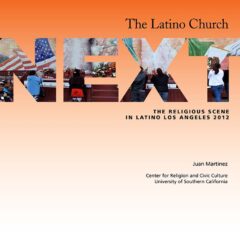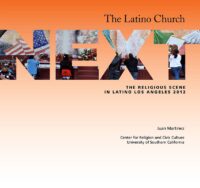As stated earlier, Latino Catholicism in Los Angeles is growing numerically, even as the percentage of Catholics in the Latino community is going down. Catholicism in Los Angeles is already a predominantly Latino and immigrant faith. Most of the anticipated growth will continue to be Latino into the foreseeable future, with other minority groups, like Filipinos and Vietnamese, also adding to that growth. But Latino/Latin American Catholicism has a different history than the European Catholicism that has predominated in the United States. This form of Catholicism developed strong popular practices, but they have often been informal practices that stand on the fringe of the official Church.
There is a long history, coming from medieval Spain, of people identifying as Catholics, but following religious devotion not always sanctioned by the Church. Catholicism among U.S. Latinos and in Latin America also developed in situations where there were often few priests, so lay leaders have been a crucial part of maintaining Catholic faith and practice among Latino faithful. Latino Catholics practice their religious devotion both within and on the fringe of the official Church. One of the most obvious practices is the devotion to the Mexican Virgin of Guadalupe. Some of the practices around Guadalupe are linked to official church practices, but Guadalupe is also a popular symbol that goes far beyond the teaching of the Catholic Church. Guadalupe has served Chicanos as a banner under which to rally, as a symbol for Latina feminists and in many other ways.
Other saints and virgin apparitions from Mexico are also venerated, though many of them are linked to local shrines in Mexico or parts of the Southwest. The Church recognizes some of these saints, but many are not “official” saints. The faithful travel to the shrines regularly and help maintain the sanctuaries. An important Salvadoran devotion is the Divino Salvador del Mundo. This is the patron of the country and has been made into an important statue in San Salvador. Members of the local Salvadoran community venerate this apparition and the church statue has been brought to Los Angeles, another immigrant among the Salvadoran community.
Some of the other common religious practices include Church approved ones like quinceñeras. But many Latino Catholics also seek out curanderos and various types of yerberos.* They also practice devotion to unofficial saints and have practices that are not officially recognized by the Catholic hierarchy. Women lead many of these popular and marginal religious practices. Latinas are at the forefront of familial piety and keep the practices alive. Even as men exclusively lead official Catholicism, popular devotion is the domain of women. And as in Protestant churches it is the women who do most of the work in predominantly Latino parishes. Church-based practices that are very popular among Latino Catholics include some that “feel” Protestant. Many Latino Catholics participate in Charismatic prayer meetings. There are also many who join in Bible studies or cursillos.
The Archdiocese of Los Angeles has a shortage of priests, like most dioceses. But it has a particularly acute shortage of Latino and other Spanish-speaking priests. The number of Latino priests is growing and the diocesan seminary, St. John´s, requires its graduates to have a ministry language, usually Spanish. But because of the shortage of parish priests, the diocese has allowed lay people to take many responsibilities in local parishes. Cardinal Mahony allowed lay leaders to become Pastoral Life Directors (PLD), practically lay pastors. Under his leadership a Latina was named a PLD. Though this is considered a “temporary” position, will the diocese make room for women to take on more parish leadership responsibilities? Will the new Archbishop Gomez, who is part of a more traditional movement, Opus Dei, encourage the naming of more PLDs or other lay leaders in the parishes? Or will he seek to take Los Angeles toward more traditional practices? Catholicism in Los Angeles is clearly becoming a religion of Latinos and other minorities. Will the official structures change to reflect the demographic realities? Will Mexican and Latin American Catholic devotions and practices find a more prominent role in Angelino Catholicism?
Juan Martinez is a former fellow with the USC Center for Religion and Civic Culture.


